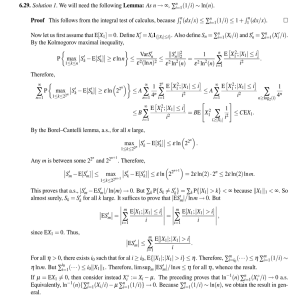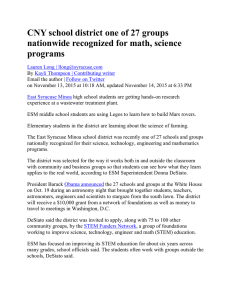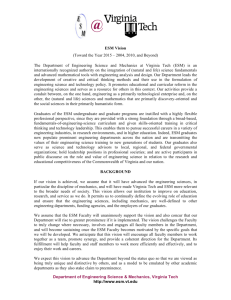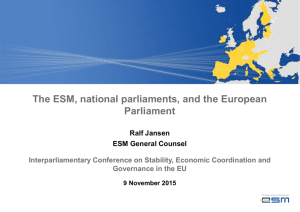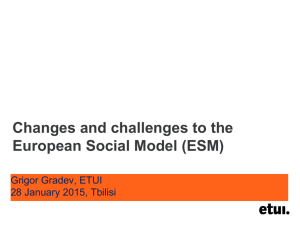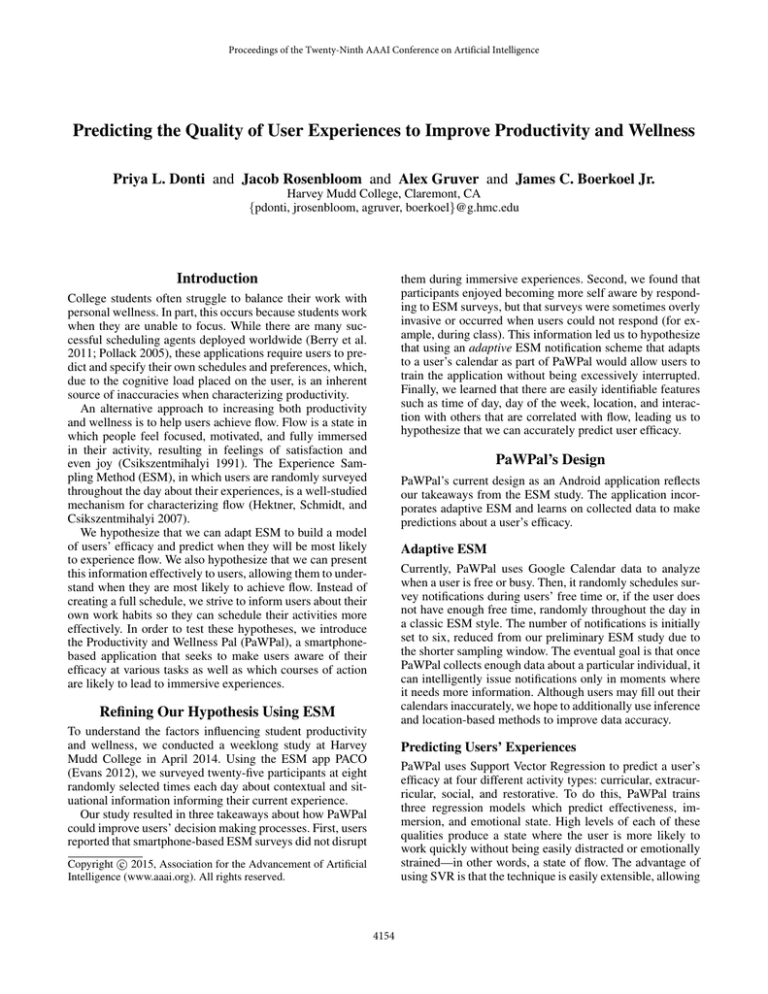
Proceedings of the Twenty-Ninth AAAI Conference on Artificial Intelligence
Predicting the Quality of User Experiences to Improve Productivity and Wellness
Priya L. Donti and Jacob Rosenbloom and Alex Gruver and James C. Boerkoel Jr.
Harvey Mudd College, Claremont, CA
{pdonti, jrosenbloom, agruver, boerkoel}@g.hmc.edu
Introduction
them during immersive experiences. Second, we found that
participants enjoyed becoming more self aware by responding to ESM surveys, but that surveys were sometimes overly
invasive or occurred when users could not respond (for example, during class). This information led us to hypothesize
that using an adaptive ESM notification scheme that adapts
to a user’s calendar as part of PaWPal would allow users to
train the application without being excessively interrupted.
Finally, we learned that there are easily identifiable features
such as time of day, day of the week, location, and interaction with others that are correlated with flow, leading us to
hypothesize that we can accurately predict user efficacy.
College students often struggle to balance their work with
personal wellness. In part, this occurs because students work
when they are unable to focus. While there are many successful scheduling agents deployed worldwide (Berry et al.
2011; Pollack 2005), these applications require users to predict and specify their own schedules and preferences, which,
due to the cognitive load placed on the user, is an inherent
source of inaccuracies when characterizing productivity.
An alternative approach to increasing both productivity
and wellness is to help users achieve flow. Flow is a state in
which people feel focused, motivated, and fully immersed
in their activity, resulting in feelings of satisfaction and
even joy (Csikszentmihalyi 1991). The Experience Sampling Method (ESM), in which users are randomly surveyed
throughout the day about their experiences, is a well-studied
mechanism for characterizing flow (Hektner, Schmidt, and
Csikszentmihalyi 2007).
We hypothesize that we can adapt ESM to build a model
of users’ efficacy and predict when they will be most likely
to experience flow. We also hypothesize that we can present
this information effectively to users, allowing them to understand when they are most likely to achieve flow. Instead of
creating a full schedule, we strive to inform users about their
own work habits so they can schedule their activities more
effectively. In order to test these hypotheses, we introduce
the Productivity and Wellness Pal (PaWPal), a smartphonebased application that seeks to make users aware of their
efficacy at various tasks as well as which courses of action
are likely to lead to immersive experiences.
PaWPal’s Design
PaWPal’s current design as an Android application reflects
our takeaways from the ESM study. The application incorporates adaptive ESM and learns on collected data to make
predictions about a user’s efficacy.
Adaptive ESM
Currently, PaWPal uses Google Calendar data to analyze
when a user is free or busy. Then, it randomly schedules survey notifications during users’ free time or, if the user does
not have enough free time, randomly throughout the day in
a classic ESM style. The number of notifications is initially
set to six, reduced from our preliminary ESM study due to
the shorter sampling window. The eventual goal is that once
PaWPal collects enough data about a particular individual, it
can intelligently issue notifications only in moments where
it needs more information. Although users may fill out their
calendars inaccurately, we hope to additionally use inference
and location-based methods to improve data accuracy.
Refining Our Hypothesis Using ESM
To understand the factors influencing student productivity
and wellness, we conducted a weeklong study at Harvey
Mudd College in April 2014. Using the ESM app PACO
(Evans 2012), we surveyed twenty-five participants at eight
randomly selected times each day about contextual and situational information informing their current experience.
Our study resulted in three takeaways about how PaWPal
could improve users’ decision making processes. First, users
reported that smartphone-based ESM surveys did not disrupt
Predicting Users’ Experiences
PaWPal uses Support Vector Regression to predict a user’s
efficacy at four different activity types: curricular, extracurricular, social, and restorative. To do this, PaWPal trains
three regression models which predict effectiveness, immersion, and emotional state. High levels of each of these
qualities produce a state where the user is more likely to
work quickly without being easily distracted or emotionally
strained—in other words, a state of flow. The advantage of
using SVR is that the technique is easily extensible, allowing
c 2015, Association for the Advancement of Artificial
Copyright Intelligence (www.aaai.org). All rights reserved.
4154
Our SVR Classifier
Mode Classifier
Mean Classifier
Imm
0.63
0.79
0.78
Eff
0.57
0.83
0.67
Em
0.53
0.59
0.62
Figure 2: Using SVR and the ESM data, we trained models
to predict the user’s immersion (Imm), effectiveness (Eff),
and emotional state (Em) while performing a given task.
This figure shows the mean absolute error from running
cross-validation on our regression model, a naı̈ve “modepicking” classifier, and a naı̈ve “mean-picking” classifier.
all users. Additionally, the final version will analyze a larger
dataset than our preliminary SVRs, as it will be used over
a long period of time, and incorporate more features than
our preliminary SVRs. These changes should improve the
predictive power of PaWPal. We hypothesize that we can
further improve predictions by adding non-temporal features such as location or interaction with others, which were
correlated with immersion, effectiveness, or emotion in the
ESM study.
Figure 1: PaWPal’s heat map homepage. Each unscheduled
block of time is shaded based on a user’s predicted efficacy.
us to add new features simply by eliciting them and labeling
new and old data with them. Using this model of efficacy,
where the overall effectiveness is the average of the scores
produced by these models, we are able to help the user decide when they would be most successful at a given activity.
Preliminary user testing led us to present this information in the heat map-style visualization shown in Figure 1.
The heat map displays each of our four activity types in a
different column. Scheduled events pulled from the user’s
calendar partition the day into unscheduled blocks of time.
Each unscheduled block of time is then shaded with concentric boxes of increasing saturation based on how effective we
predict the user will be at the corresponding activity.
Conclusions
In this paper, we have presented a new smartphone application called PaWPal that seeks to make users aware of
their efficacy at various tasks using a combination of adaptive ESM and SVR classification. PaWPal shows promise
in learning and contextualizing a user’s experiences within
their schedule, helping them choose activities that maximize
their opportunities for productivity, wellness, and flow. We
plan to conduct a user-study of the full application in the
spring of 2015, which will include additional contextual features such as location and current level of interaction. We
hope that this will increase the accuracy of PaWPal’s predictions. With these additional features, we believe that PaWPal
will provide users with reliable information about their work
habits and support their personal wellness.
Preliminary Evaluation
To test the quality of our predictions, we ran our SVR on
data obtained during the ESM study. We hand-tagged this
data using several temporal features (e.g., the time of day
and day of the week) along with contextual data from users’
calendars (e.g., whether the data point fell in a scheduled
block of time). When deployed, we expect that PaWPal will
be able to collect at least this amount of data from users.
In one test, we ran cross-validation with three different
types of models. The first model was an SVR trained using a
coarse grid search over parameters. The second was a naı̈ve
classifier that simply predicted the mode of its training data
as the label for all testing data. We chose this mode-based
model for comparison as users often picked “3” as their response to 4-point “forced choice” Likert questions in our
ESM study. The third classifier was similar to the second except that it used the mean of its training data. For each model
type, we ran the cross-validation ten times and noted the
mean absolute error of the efficacy predictions when compared to the efficacy the user reported for that data point
as part of the ESM study. As shown in Figure 2, we found
that our regression model performed significantly better than
both naı̈ve models.
Our tests show encouraging results, and we have many
reasons to believe that PaWPal’s performance can be even
better. We expect the final version of PaWPal to use individualized data for predictions instead of predicting across
Acknowledgements
Thanks to Bob Evans, Evelyn Cho, Qutayba Abdullatif, Jeb
Brooks, and Emi Reed for their help with ESM and PaWPal.
References
Berry, P. M.; Gervasio, M.; Peintner, B.; and Yorke-Smith, N.
2011. Ptime: Personalized assistance for calendaring. ACM
Transactions on Intelligent Systems and Technology 2(4):40.
Csikszentmihalyi, M. 1991. Flow: The psychology of optimal
experience, volume 41. HarperPerennial New York.
Evans, B. 2012. Data-driven self-improvement: Paco. A
talk by Bob Evans, creator of PACO (Personal Analytics Companion) about ESM and self-awareness at TEDxClaremontColleges 2012. [Accessed: 2014 09 09].
Hektner, J.; Schmidt, J.; and Csikszentmihalyi, M. 2007. Experience Sampling Method: Measuring the Quality of Everyday
Life. Thousand Oaks: Sage Publications, Inc.
Pollack, M. E. 2005. Intelligent Technology for an Aging Population. AI Magazine 26(2):9–24.
4155

